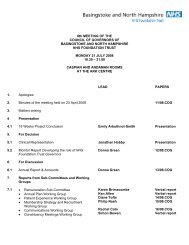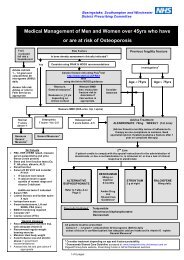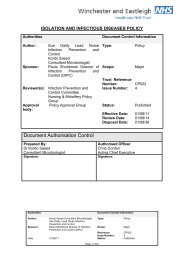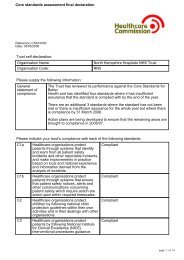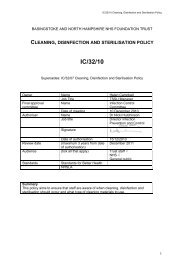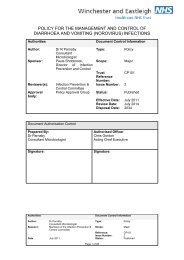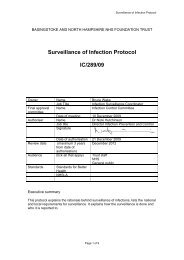New Strain Respiratory Virus Policy - Hampshire Hospitals NHS ...
New Strain Respiratory Virus Policy - Hampshire Hospitals NHS ...
New Strain Respiratory Virus Policy - Hampshire Hospitals NHS ...
Create successful ePaper yourself
Turn your PDF publications into a flip-book with our unique Google optimized e-Paper software.
Winchester & Eastleigh Healthcare <strong>NHS</strong> Trust<br />
<strong>New</strong> <strong>Strain</strong> <strong>Respiratory</strong> <strong>Virus</strong> <strong>Policy</strong><br />
needs on the implementation of new or updated policies. They are<br />
responsible for ensuring adequate facilities and resources are available to<br />
adhere to this policy and that any changes in practice are implemented. Line<br />
managers are responsible for ensuring that all Infection Control (IC) policies<br />
and procedures are accessible for all their staff and that their staff have read<br />
them.<br />
All Trust employees<br />
All staff are responsible for ensuring their compliance to this policy to ensure<br />
the safety of all patients, staff, visitors and contracted staff to this Trust.<br />
Information regarding the failure to comply with this policy e.g. lack of training<br />
or inadequate equipment must be reported to the line manager and the<br />
incident reporting system used where appropriate. If patient or staff safety is<br />
compromised as a result of the revised policy, staff must inform their line<br />
manager and ensure that a risk assessment is completed and reported<br />
through divisional risk forums and the Trust Patient Safety Manager.<br />
It is the responsibility of individual practitioners to ensure they receive the<br />
education they require to improve their knowledge, skills and competence as<br />
stated in CP072 Training policy for employees of WECHT in infection control.<br />
They are accountable to themselves, their line manager and the patient in<br />
acknowledging their limitations and to verbalize their concerns in caring for<br />
patients who have a new strain of respiratory virus such as influenza.<br />
4 INTRODUCTION<br />
Viral diseases pose a continual threat to human populations. As we live in<br />
ever-increasing populations and become increasingly mobile so it is inevitable<br />
that new viruses, such as SARS-CoV or new hyper-virulent influenza stain will<br />
appear.<br />
<strong>Respiratory</strong> infections are common including rhinoviruses, respiratory<br />
syncytial virus, influenza viruses A, B and C, para-influenza viruses and<br />
coronaviruses including SARS. Most infections with these viruses are fairly<br />
mild, self-limiting and confined to the upper respiratory tract. However, these<br />
viruses can undergo genetic changes and mutations and can emerge or reemerge<br />
as more virulent agents and cause more severe infections and even<br />
death. A new type or sub type of respiratory viruses may arise at any time,<br />
the main processes in the evolution of emerging new viruses are not fully<br />
clear, particularly the selection pressures faced by viruses in new host<br />
species. Although the high mutation rates of RNA viruses like Influenza and<br />
SARS provide them with great adaptability and explain why they are the main<br />
cause of emerging diseases, their limited genome size means that they are<br />
also subject to major evolutionary constraints. Viral genetic factors have also<br />
Authorities<br />
Document Control Information<br />
Author: Sue Daiilly Lead Nurse Infection Type:<br />
<strong>Policy</strong><br />
Control<br />
Sponsor: Paula Shobbrook Director of Infection Scope:<br />
Major<br />
Prevention and Control<br />
Reference:<br />
CP104<br />
Issue Number: 2<br />
Date May 2010 Status: Final<br />
Page 6 of 27




